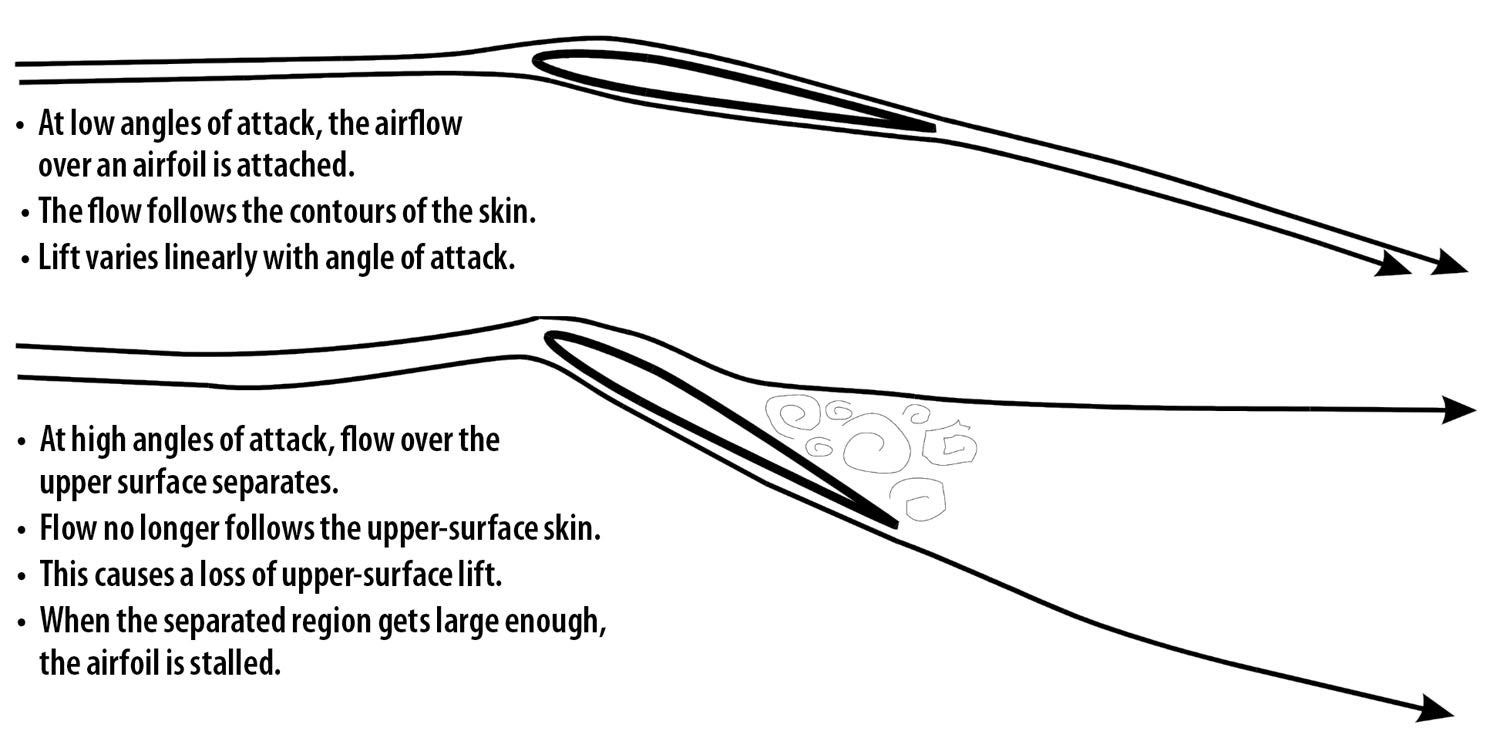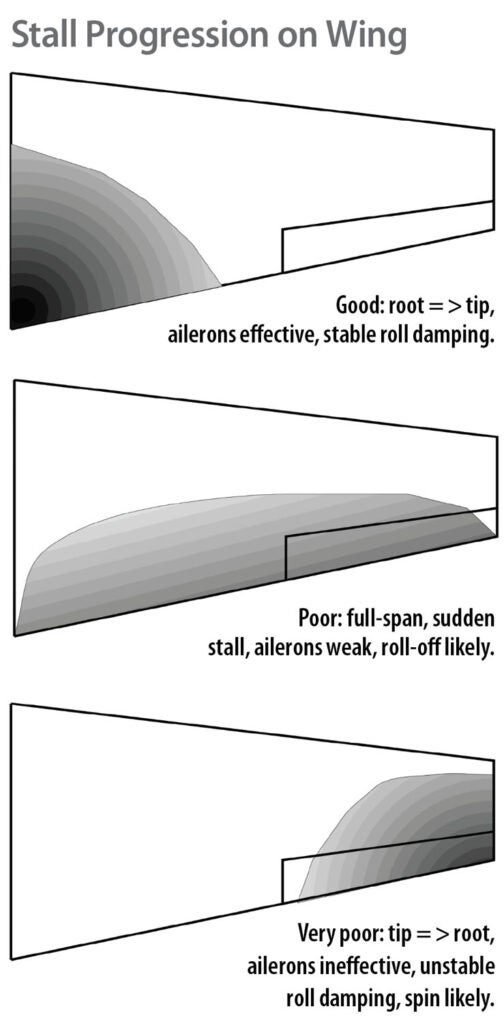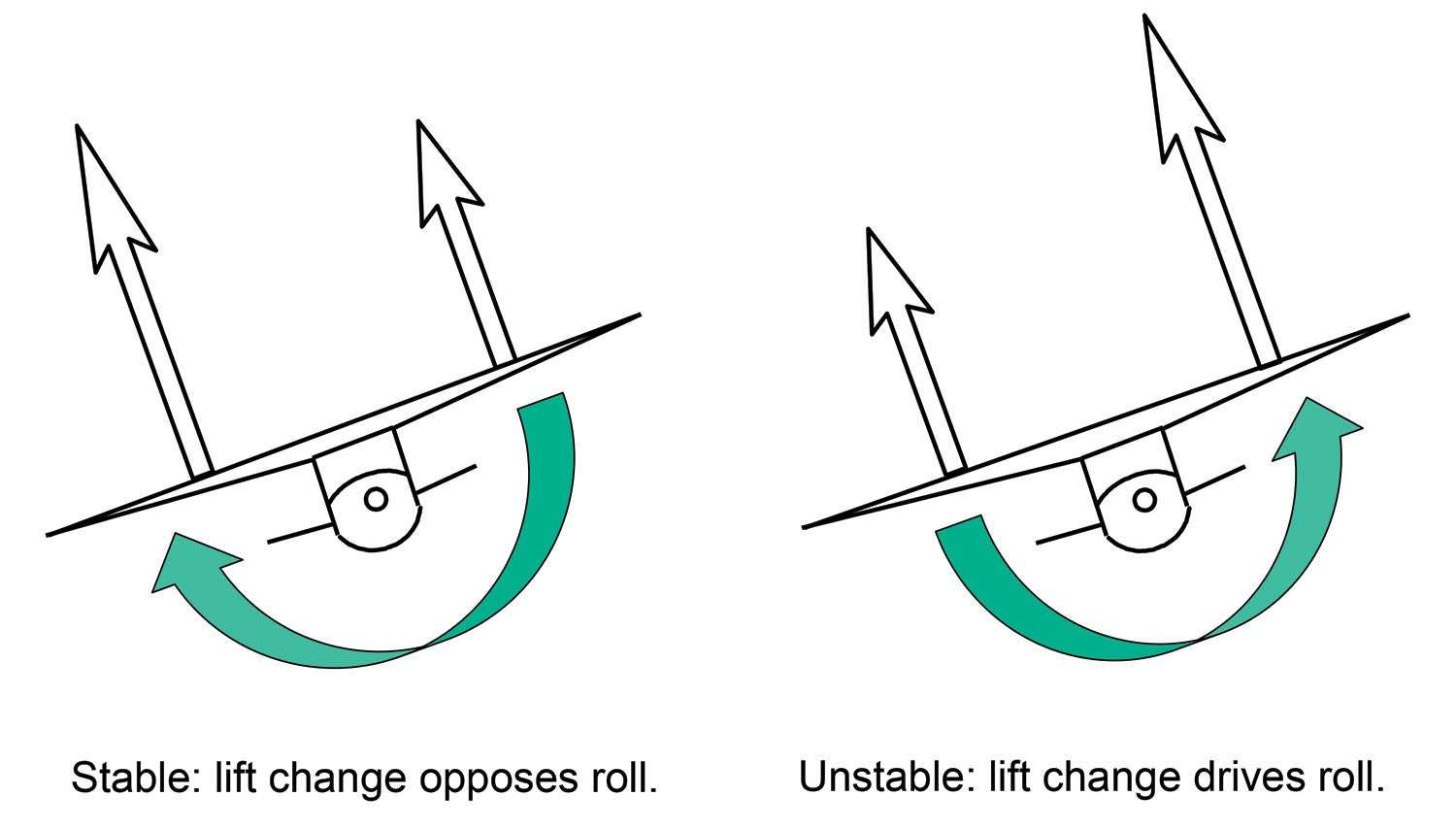Last time we took a look at the effect of twisting the wing. Wing twist is used to adjust both the spanwise distribution of lift and the spanwise distribution of lift coefficient (Cl). These serve two different purposes.
Tailoring the lift distribution is used to optimize the span loading to increase span efficiency and minimize induced drag.
Tailoring the distribution of Cl is used to provide safe stall characteristics.
Airfoil Stall
At a low angle of attack (AOA), the airflow over an airfoil is fully attached. The air flows smoothly over the entire chord of the airfoil. As AOA increases, the lift of the airfoil will increase linearly until the angle of attack reaches a critical value. At this critical AOA, the airflow over the upper surface will begin to break away from the surface. When the flow starts to separate, the lift of the airfoil increases less with increased AOA. As the amount of separation increases, the lift will eventually start to decrease with increasing AOA. (See Figure 1).

Airplane Stall
As we have seen previously, at any given angle of attack the lift coefficient varies along the span of the wing. As AOA increases, the local Cl will reach the Clmax of the airfoil at some station along the span and the flow will begin to separate at that point. As AOA increases, the area of flow separation on the wing will increase.
When enough of the wing is stalled, the wing reaches its maximum lift, and lift begins to decrease with further increases in AOA. Any attempt to trim the airplane to a higher AOA will result in a loss of lift, and the airplane will be unable to maintain that flight condition.
Stall Characteristics
For the airplane to have safe stall characteristics, the pilot must be able to maintain control of the airplane as the stall develops and be able to push the nose down and reduce the angle of attack to break the stall.
For most general aviation airplanes, the wing’s effect on pitch characteristics at the stall is primarily a function of how abruptly its airfoil stalls. This affects how sudden the onset of a stall is, but unless the wing planform has a significant amount of sweepback, the wing’s contribution to pitching moment at the stall will be nose down. There are other configuration effects that can cause pitch-up or other undesirable longitudinal characteristics in a stall, but they are subjects for another time.
For most general aviation airplanes, the primary axis of concern for stall characteristics is roll.
Roll Control and Roll Damping
How well the airplane behaves when stalled depends on how the stall develops along the span of the wing. As illustrated in Figure 2, it is best if the wing stalls first at the root.

For the pilot to be able to maintain control in roll at the stall, two things are necessary.
First: The ailerons must remain effective and provide roll control in the proper direction. If the ailerons become ineffective, or if the stall causes aileron control reversal, the pilot will not be able to command the airplane in roll.
Second: The airplane must retain lateral stability and stable roll damping. If these conditions are met, the airplane will not tend to roll off at the stall or try to enter a spin on its own. If not, it will tend to depart into a spin entry at the stall.
How the stall progresses along the wing has a large effect on both of these.
Roll Control
Looking at Figure 2 we can see that if the stall starts at the root, the wing will have attached flow over the outer panel as the stall starts. Since there is still good airflow over the ailerons, the pilot will still have good roll control.
As the initiation of the stall moves outboard, the flow over the ailerons gets more separated and roll control degrades.
A wing that stalls first outboard of the mid semi-span will lose aileron effectiveness early in the stall. In extreme cases, aileron control inputs may exacerbate the stalling of the portion of the wing to which the aileron is attached. In this case, deflecting an aileron downward will exacerbate the local stall and cause that portion of the wing to lose lift, while deflecting the opposite aileron upwards will reattach the flow and increase lift. The lift changes will be opposite of those for normal flight, and aileron control will be reversed, causing the airplane to roll away from the direction of the stick input. This is unsatisfactory and extremely dangerous since the airplane will be uncontrollable in roll, and a pilot’s normal instinctive stick input in response to any roll will accelerate the roll and cause the airplane to depart into a spin entry.
Lateral Stability and Roll Damping
Both the lateral stability and roll damping of the airplane are determined by how the lift of the wing varies with angle of attack. In normal flight, increasing AOA increases lift, and the wing is said to have a “positive lift-curve slope.” Post stall, the lift drops with increasing angle of attack and the slope of the lift curve is negative.
During the initial stages of the stall of a complete wing, the lift-curve slope of the stalled region is negative, while the lift-curve slope of the un-stalled region is positive.
Lateral Stability
The lateral stability of the airplane (also called dihedral effect) is determined by how the airplane responds in roll when it is yawed relative to the airstream.
An airplane with stable dihedral effect will roll in the same direction as the yaw. Yawing nose left will cause a left-wing-down roll, and yawing nose right will cause a right-wing-down roll.
This happens because, due to dihedral, the AOA of the advancing wing is increased and the AOA of the retreating wing is decreased when the airplane yaws. This causes the lift of the advancing wing to increase and the retreating wing to decrease, generating a rolling moment toward the retreating wing. This is the aerodynamic phenomenon that allows a pilot to “pick up a wing with rudder” by generating rolling moment with rudder-induced yaw instead of the ailerons.
Post stall, this situation reverses. If the lift-curve slope of the wing is negative, then the lift of the advancing wing decreases, the lift of the retreating wing increases and the airplane will roll toward the advancing wing.
When the wing is partially stalled, dihedral effect depends on the relative roll leverage of the stalled and un-stalled parts of the wing. The outer portion of the wing has a larger lateral moment arm than the inner portion. If the stall starts at the root, the outer part of the wing will still have a positive lift-curve slope and will still provide enough stable dihedral effect to overcome the unstable contribution of the stalled inner portion. The airplane will retain lateral stability during the incipient stall.
If the outer portion of the wing stalls first, the reverse is true and the airplane will become unstable laterally at the stall. It will tend to roll off, and the roll will get worse if the pilot tries to correct the initial departure with rudder.
Roll Damping
Roll damping is the airplane’s rolling-moment response to a roll rate. Roll damping is stable if the rolling moment generated by a roll rate opposes the roll and unstable if it accelerates the roll. As illustrated in Figure 3, roll damping depends on how the lift of the wings changes with roll rate.
Rolling the airplane causes the AOA of the descending wing to increase and the AOA of the rising wing to decrease. At pre-stall AOA, where the lift-curve slope of the wings is positive, this increases the lift of the descending wing and decreases that of the rising wing. This causes a lift differential between the wings that generates a rolling moment opposite to the direction of the roll, giving the airplane stable roll damping.
During the stall, the effect of where on the wing the stall starts on roll damping is similar to its effect on lateral stability. If the stall starts inboard on the wing, the airplane will have stable roll damping during an incipient stall. Any initial roll rate will be opposed by the roll damping and die out.
If the stall starts outboard on the wing, the airplane will have negative (unstable) roll damping. As the airplane starts to roll, the wing will produce a rolling moment that propels the roll, causing the roll to accelerate. Negative roll damping is the primary aerodynamic phenomenon that drives a spin. The unstable rolling moment drives and sustains the rotation.

Wing Twist
As we saw last month, wing twist affects the spanwise distribution of local lift coefficient. This is what the designer can use to define a wing that stalls from the root first. For any planform, it is possible to come up with a twist distribution that ensures that the local Cl at the root reaches its airfoil’s Clmax before the outer portion of the wing. This will almost always be a washout, where the wing is twisted leading edge down at the tip relative to the root.
There appears to be a temptation, particularly in the homebuilt community, to minimize or eliminate wing twist to try to reduce drag and increase performance. This is a dangerous mistake. Eliminating twist will save little or no drag and can make the airplane dangerous to fly because of its effect on stall characteristics.
It is critical for safety of flight that the airplane retains stable roll damping and lateral stability at the beginning of the stall. The primary way to ensure this is to put the proper twist in the wing.














Thank you sir. Good information, very well explained.
Wouldn’t flapperons provide the same thing without the need for twist?